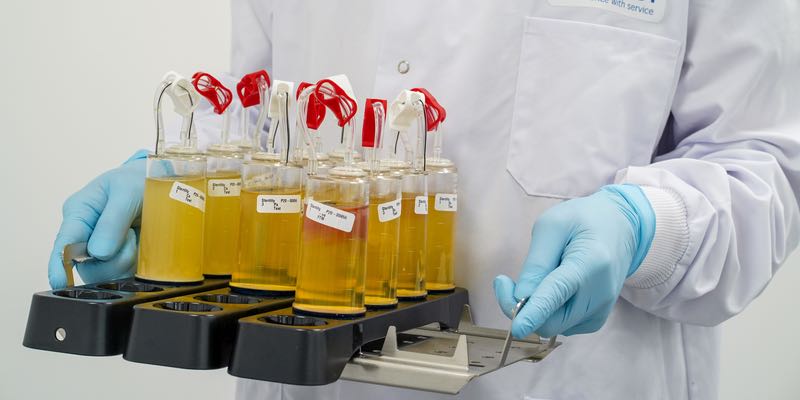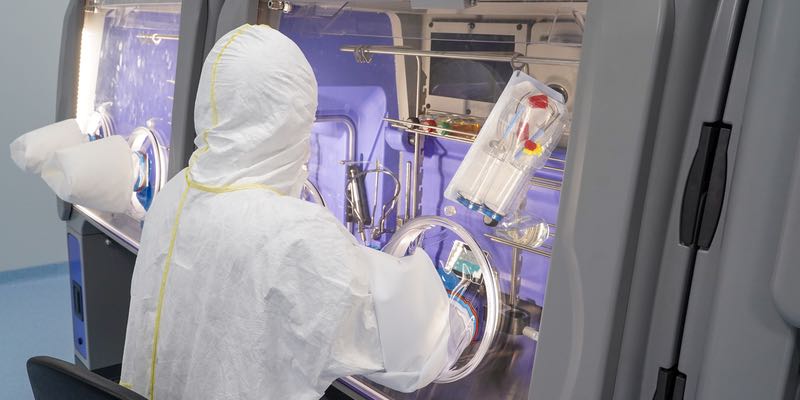New ventures require ambitious minds. Reading Scientific Services Ltd (RSSL) made their first venture into cleanroom technology and sterility testing, making sure to choose their team wisely. Jamie Tempest and Reginald Fernandes are the two team members who lead the company's newest endeavour for a sterility testing suite.
Both experts from RSSL have backgrounds in biological sciences that progressed into microbiology with slightly different specialisms. Tempest completed a BSc in Biology and explains that after this he became the site microbiologist for a small manufacturer who had a range of Grade D cleanrooms. This led him to his current job as Pharmaceutical Microbiology Scientist. "I have had the opportunity to be a consultant with many clients on how to monitor/operate their cleanrooms whilst working for RSSL so the side of the role that involved cleanrooms/isolators was something that I was well versed in," Tempest says.
I predict that over the next 5-10 years we will see a bigger technological advance than in the last 15-20
Tempest is also completing an MSc in Pharmaceutical Microbiology, and this is where the balanced team selection from RSSL comes into play. Since graduating, his colleague Fernandes worked as a bench scientist and then for a large microbiology company (Thermo Fisher Scientific). When Fernandes joined RSSL as Pharmaceutical Microbiology Laboratory Manager in 2019, he had significant industrial and clinical microbiology experience, but limited pharmaceutical microbiology knowledge. Combining academic expertise with industrial experience created a well-balanced team needed for the upcoming project.

The choice of microbiologists as leaders in this project is a factor that can't be understated. "A cleanroom is designed to control the number of particles. These particles have the potential to carry microorganisms and there is no one better trained to understand this risk than an appropriately trained microbiologist," enthuses Fernandes. "With this understanding, they can aid cleanroom design by being able to identify high-risk areas and help implement appropriate engineering controls to feed into the contamination control strategy."
Journey of a build
As many constructors will know, the planning stage can make or break a project. This is something the team learnt first-hand. "Having been given a short time scale it was essential that all parts of the process fitted together and that the various manufacturers and suppliers were all talking to each other and fitting their processes around one another," says Tempest.
"I think given the nature of what we were trying to achieve, we were very good at mapping the overlapping processes, working with the cleanroom and isolator teams to deliver symbiotically, in turn working with our quality team for the highest standards," Fernandes adds.
Many learn how to follow an SOP, but not the knowledge behind it
The two scientists were eager to put their expertise to use. "We wanted to ensure that the background environment to the isolators was not a source of contamination for the test. The easiest way to do this was to have a cleanroom environment and everything that encompasses it," Tempest says. Although there is no regulatory requirement to house isolators in a Grade D cleanroom for sterility testing, both team leaders thought it would be good practice and provide more options to advance services in the future.
When discussing tactics for quick and efficient MHRA inspection, Fernandes stressed the importance of mock inspections. "We employed a specialist consultant to work with us on all elements of project management and to perform a mock inspection to ensure we had not overlooked any key elements. This included working closely with Quality Assurance when devising SOPs."
Training standards
With high standards set, the top source of cleanroom contamination was a key focus. Notoriously this stems from people, which is why Tempest and Fernandes ensured that the design of the facility (air changes, pressure cascades, HEPA filtration) and appropriate gowning training were implemented meticulously, with a routine EM programme to prove they all worked effectively.
As microbiologists, both Tempest and Fernandes know the importance of not just well-trained, but also well-informed operators, to reduce contamination. "My previous experience of sterility testing was all academic, based on my knowledge gained during my MSc studies, and because of this we placed a job advert for this role with the view that I would support someone heading up the sterility unit," said Tempest. "It was becoming apparent that there was a lack of knowledge from interviewees. Aside from actually performing the test, they did not understand the intricacies. They had learned how to follow an SOP, but without the knowledge behind it."
Sporicide needs to be proven against the organisms you are finding not just those in ISO standards
From this it was decided that it was best to fill the practical gap Tempest had himself, so he spent 2019 doing this, while design and build was ongoing. This training gave Tempest the practical know-how to tailor training of staff. "We had to tailor almost everything actually. In particular, the robustness and training of the gowning process," he says.
Fernandes explains how the final system flows to avoid human contamination. A protocol was put in place so everything follows a designated flow through the suite. Samples enter into the first room (entrance area), where they are wiped down with Isopropyl alcohol and the item is passed into a HEPA-filtered transfer hatch. This hatch is then interlocked and after a set period of time, operators can retrieve the items. Contamination comes in many forms and knowing your microbes is crucial.
"Bacterial endospores are harder to kill than fungal spores. However, a bacterium can only make one endospore per cell, whereas a fungal cell can make many," Tempest says as an example. "Bacterial and fungal spores can be found in many places such as cardboard pallets and the dirt on shoes, so will inevitably find their way in at some point. This brings you on to how do you kill them," he continues. "Use of a sporicide alongside your other disinfectants is essential, moreover the use of a sporicide proven on the surfaces you have in your cleanroom and against the organisms you are finding, not only against those in ISO standards."
The future
RSSL chose to build a sterility suite as there was sustained demand from its sterile manufacturing clients. However, there has been another benefit, "In response to the pandemic, we saw a rise in demand for sterility and had to increase resource and accelerate training. This has enabled our clients to ramp up their production on critical care products," says Fernandes. Tempest adds, "RSSL has been approached not only to act as back up and extra capacity for other service providers, but also to help out where clients have their own staff self isolating to pick up more routine tests." It was also noted that many clients are looking at their Business Continuity Plans and recognising the importance of a robust supply chain with more than one approved supplier. "This has meant a high demand on our sterility services which we are proud to say we are coping with superbly."
The field is moving away from reliance on the horseshoe crab with Recombinant Factor c (RFc)
The new suite was a project 12-14 months in the pipeline. This covered the initial design concepts through to final MHRA approval. But the team is not sitting on their laurels now. "The cleanroom currently houses Bioquell Qubes and has been designed as such with expansion in mind. We will be looking to offer additional sterility testing capacity as well as expand into rapid sterility testing in the near future," Tempest explains.
Now the team has dipped their toes in the sterility testing pond, Fernandes and Tempest are excited to see where the field goes. Tempest says he is seeing great advances in the technology around rapid methods for microbial detection, both for bioburden and sterility testing such as ATP bioluminescence. "It is difficult to predict which of the methods will prevail as the gold standard, although it is promising to see regulators are now encouraging the use of these methods here in Europe, and in the US."

Fernandes made sure to future-proof the build to allow incorporation of any new innovations when possible. "We are seeing client interest within these [real-time monitoring] areas and particularly on-line monitoring for water systems. I think these will be seen more prevalently in the sterile manufacturing sector and will even filter down to non-sterile manufacturing purely on a cost to risk-benefit basis. RSSL is proactively looking into this, it is a question of watch this space!"
These innovations are even more exciting to Tempest because historically he thinks microbiology in the pharma industry has been very slow to change. "I think the emergence of rapid microbial methods has really changed some aspects of microbiology, such as MALDI-ToF increasing the speed of identification massively and the evolution of the endotoxin test we have seen from Gel clot through to LAL and now onto moving away from reliance on the horseshoe crab with Recombinant Factor C (rFC)," he says. This is an acceleration of innovation that both scientists are hoping won't slow down.
As new therapy types appear they hope this only drives microbiology further and faster. With the rise of new cell and gene therapy, for example, Fernandes thinks we could see the acceleration of the acceptance of parametric release and rapid testing, and this could be a real game-changer. "With the way technology is moving forward, I predict that over the next 5-10 years we will see a bigger technological advance than in the last 15-20," Tempest enthuses.
